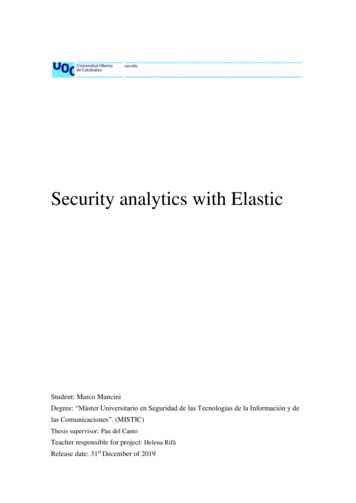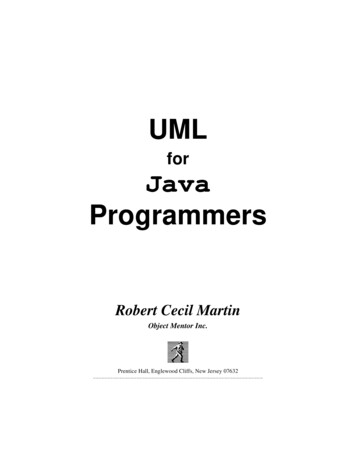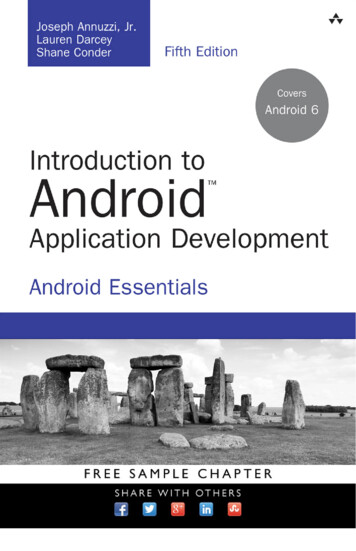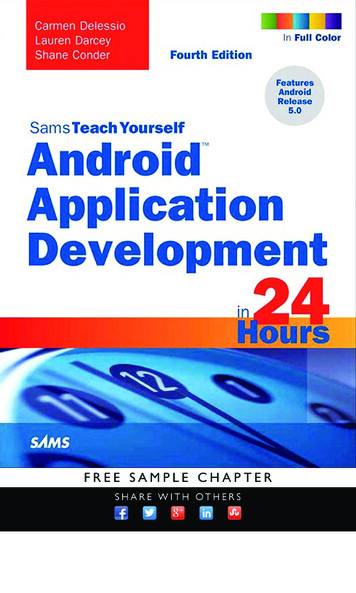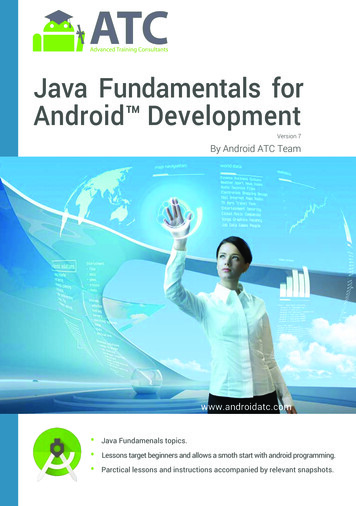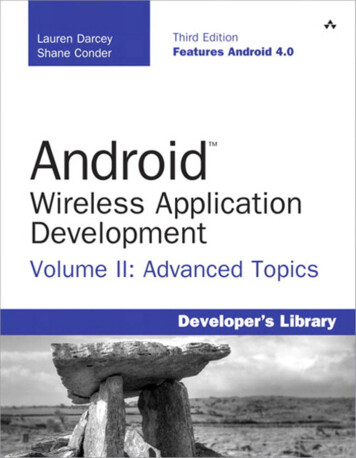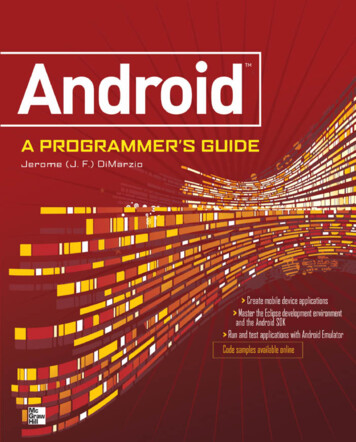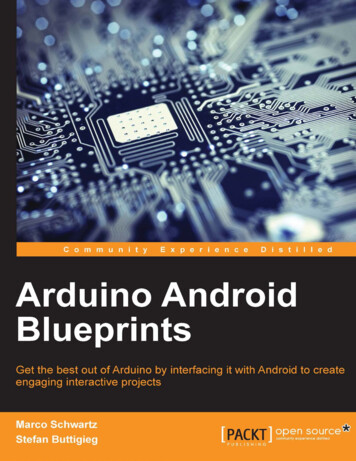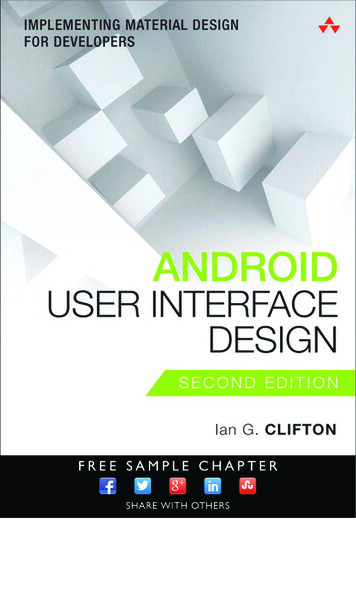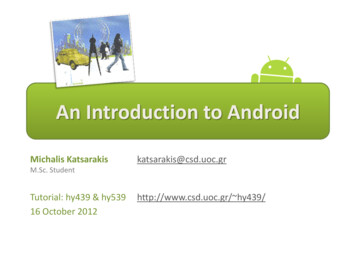
Transcription
An Introduction to AndroidMichalis Katsarakiskatsarakis@csd.uoc.grM.Sc. StudentTutorial: hy439 & hy53916 October 2012http://www.csd.uoc.gr/ hy439/
Outline BackgroundWhat is AndroidAndroid as a SensorDevelop for Android
Background
BackgroundInternet users and Mobile phone users
BackgroundOpen Handset Alliance (OHA)Mobile OperatorsSemiconductor CompaniesHandset ManufacturersSoftware CompaniesCommercialization Companies
What is Android?
What is Android?Android delivers a complete set of software for mobile devices: Operating System Middleware Key mobile applications Open Breaking down Application Boundaries Fast & Easy Application Development
What is Android?History of Android 2001 search service for wireless device2005–––– Acquire Android(Andy Rubin: Danger CEO, Development Sidekick of T-Mobile)Acquire Skia(2D Graphics for mobile device)Acquire RegWireless(Browser and Email for mobile device)Move Engineers from PlamSource(Dianne Hackborn, etc )2007 Nov 5: Android announced2007 Nov 12: Android SDK released by OHA2007 Dec 14: Bug-fix SDK released2008 Jan 3: Android Developer Challenge I starts accepting submissions2008 Feb 13: m5-rc15 SDK released2008 Apr 14: 1788 total submissions for Challenge I2008 May 12: Top 50 Applications in Challenge I announced2008 Nov: Android Phone(G1 Phone by HTC/T-mobile)2008 Nov: Full Source Open2009 Apr: HTC Magic2009 July: HTC Hero, Samsung i7500, Android Netbook, Set-top 2009 Aug: Android Developer Challenge II
What is Android?Open SourceUsersDeveloperIndustryIndustry Software stack opensourced under Apache2.0 license Source available afterfirst handsets ship Anyone will be able tobuild a system imageUsers Users have control oftheir experience They control what getsinstalled They choose the defaultsDeveloper Don not needpermission to ship anapplication No hidden or privilegedframework APIs Can integrate, extendand replace existingcomponents
What is Android? Open SourceA Developer can:IntegrateExtendReplace
What is Android?Android Architecture
What is Android? Android ArchitectureLinux Kernel Android OS is built on top of the Linux 2.6 Kernel– Linux Core functionality Memory managementProcess managementNetworkingSecurity settings– Hardware drivers
What is Android? Android ArchitectureLibraries Android’s native libraries.–––––––––Libc: c standard lib.SSL: Secure Socket LayerSGL: 2D image engineOpenGL ES: 3D image engineMedia Framework: media codecsSQLite: Database engineWebKit: Kernel of web browserFreeType: Bitmap and VectorSufraceManager: Compose window manager with off-screen buffering.
What is Android? Android ArchitectureAndroid Runtime Core Libraries– Provides the functionality of the JAVA Programming Language Dalvik VM–––––A type of Java Virtual MachineRegister based (not stack machine like JVM)Optimization for low memory requirementsExecutes .dex (Dalvik-Executable) files instead of .classDX tool converts classes to .dex formatEach Android application: runs on its own Process runs on its own Instance of Dalvik VM is assigned its own Linux user ID
What is Android? Android ArchitectureApplication Framework The blocks that our applications directly interact with. Important blocks:– Activity Manager: Manages the activity life cycle of applications– Content Providers: Manage the data sharing between applications– Telephony Manager: Manages all voice calls. We use telephonymanager if we want to access voice calls in our application.– Location Manager: Location management, using GPS or cell tower– Resource Manager: Manage the various types of resources we use inour Application
What is Android? Android ArchitectureApplications This is where our applications are placed. Some pre-installed applications:––––SMS client appDialerWeb browserContact manager No compulsory applicationsEquality among appsEasily embedded web browserParallel running As developers, we are able to write an app whichreplaces any existing system app.
What is Android? Android ArchitectureDetails Design goalsAppsJavaApp FrameworkLibrariesCC/C Linux KernelRuntime––––Open SourceHigh flexibilityHigh data accessibilityRapid development(XML, Java) Used Languages––––App: JavaFramework: JavaLibraries: C/C OS & Drivers: C
Android Device as a Sensor
Android Device as a SensorMotion Sensors: Accelerometer GyroscopePosition Sensors: Magnetometer Proximity GPSEnvironmentSensors: Barometer Photometer Thermometer After user authorization, an app can access detailed sensorreadings, using the Application Framework layer.NetworkInterfaces: GSM/CDMA 802.11 Bluetooth
Develop for Android
Develop for AndroidAndroid SDK Android-sdk–––––add-onsdocs (Javadoc style documentation)extrasplatformsplatform-tools adb– samples (sample applications)– temp– tools emulator– SDK manager.exe
Develop for AndroidAndroid SDK Emulator– Android applications may berun on a real device or onthe Android Emulator, whichships with the Android SDK. ADB (Android Debug Bridge)– The ADB utility lets youconnect to the phone itselfand issue rudimentary shellcommands, such as copyingfiles to and from the device.
Develop for AndroidDevelopment Environment JDK 5 or 6 Eclipse IDE– JDT plugin– ADT plugin
Develop for AndroidApplication Fundamentals Development Language: Java Android SDK tools compile the code into an Androidpackage, an archive file with an .apk suffix Security sandbox– Each application has a unique Linux user ID– Each process has its own virtual machine (VM)– Every application runs in its own Linux processPrinciple of least privilege: Each application,has access only to the components that itrequires to do its work and no more.Android ApplicationDalvik VMLinux ProcessLinux Kernel
Develop for AndroidApplication ComponentsAppActivitiesAn activity represents a single screen with auser interface.ServicesContent ProvidersA content provider manages a shared set ofapplication data. Through the contentprovider, other applications can query oreven modify the data.A service is a component that runs in thebackground to perform long-runningoperations or to perform work for remoteprocesses. A service does not provide auser interface.AndroidManifest.xmlBroadcast ReceiversDeclares: app components , minimum APILevel, needed API libraries, userpermissionsA broadcast receiver is a component thatresponds to system-wide broadcastannouncements.
Develop for AndroidCases
Develop for AndroidCases
Develop for AndroidCase: Hello World
Develop for AndroidActivityLifecycle
Develop for AndroidServiceLifecycle
Develop for AndroidIntents Activities, Services, and Broadcast Receivers areactivated through intents. What is an Intent?– Message (Bundle of information)– Facility for late run-time binding between components– Passive data structure describing an operation to beperformed– Description of something that has happened and isbeing announced
OutlineNext Tutorial Practical Exercise on Android Development– Hello World– Multiple Activity Application– 802.11 RSSI measurements
Resources Introduction to loads/detail?name Introduction%20to%20Android.pdf Android oid-architecture.html Application ponents/fundamentals.html i/declaring-layout.html
Develop for Android Development Language: Java Android SDK tools compile the code into an Android package, an archive file with an .apk suffix Security sandbox –Each application has a unique Linux user ID –Each process has its own virtual machine (VM) –Every application runs in its own Linux process Linux Process Linux Kernel
